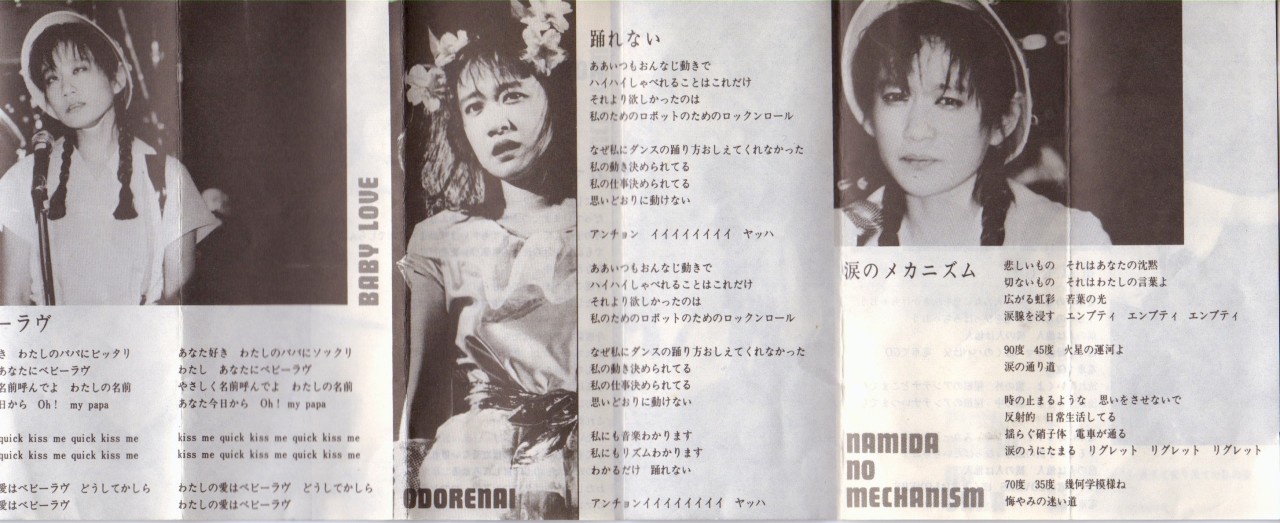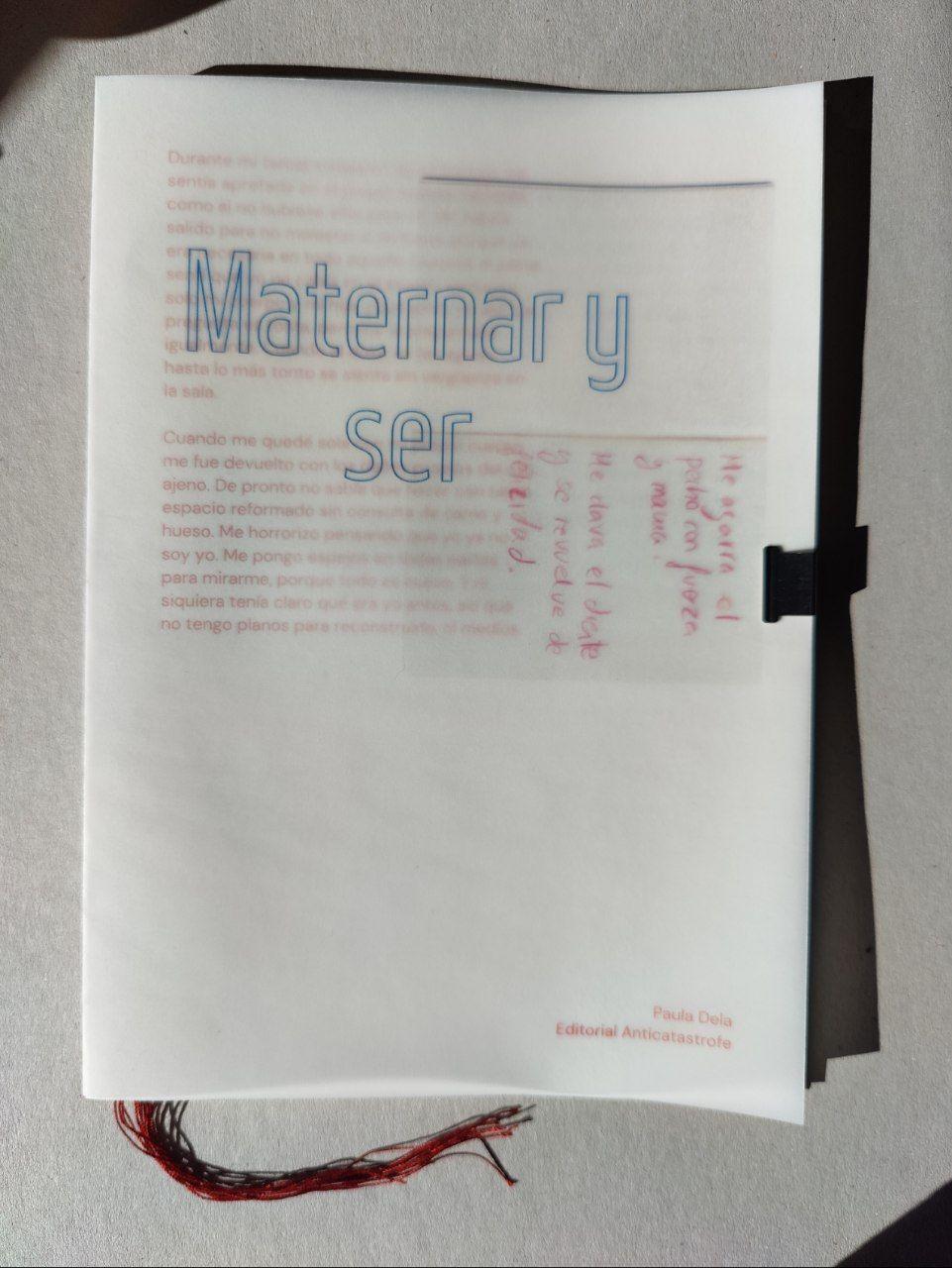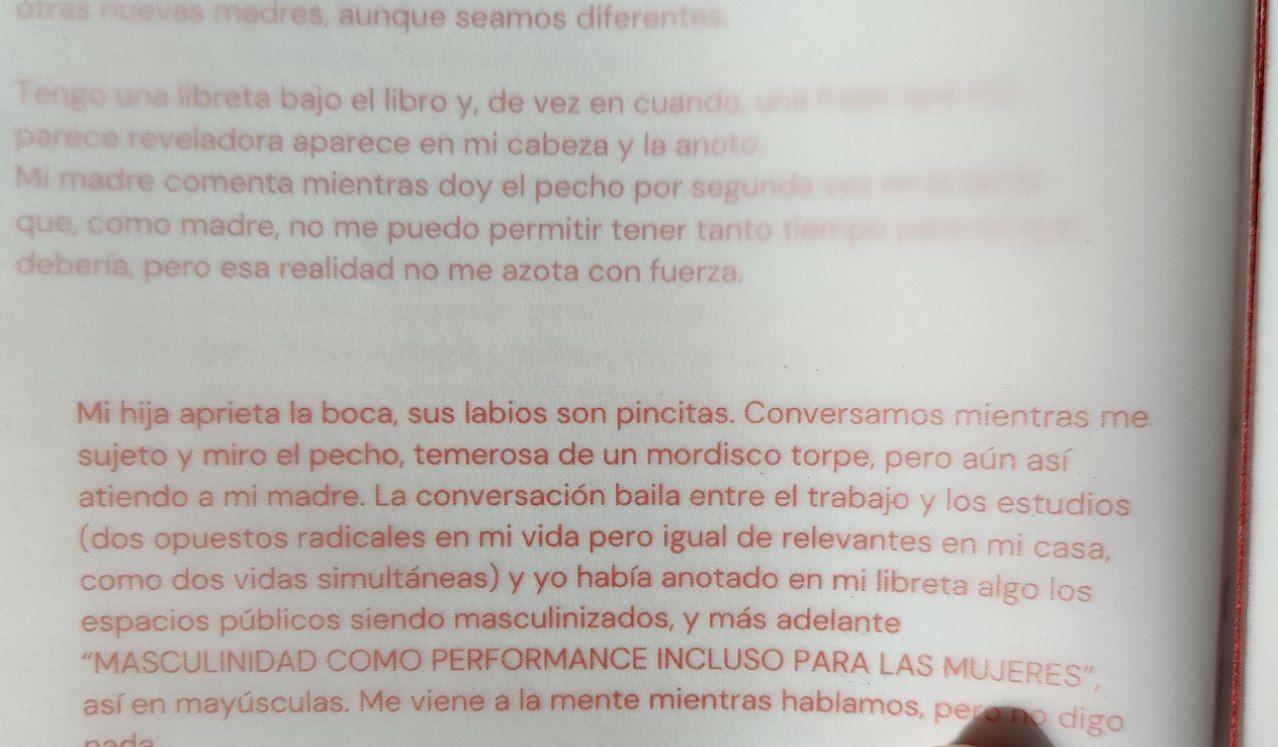Want to join in? Respond to our weekly writing prompts, open to everyone.
AdventOfProgress Day 17
from  Build stuff; Break stuff; Have fun!
Build stuff; Break stuff; Have fun!
I'm at a point where I can focus more on the UI. And this will be time-consuming. This is a lot of trying out and seeing what sticks. It's a lot of fun, but I need to limit myself and not overdo it here. 😅
So, today I got a lot of stuff done. Refined the spacing and tried to make it even on all screens. Improved the styling of the forms and buttons. And cleaned up the styling itself, so it looks a bit more minimal.
I want to show more, but I also would like to keep it a secret what app and style I'm working on. So the posts get a bit shorter. I just want to describe what I have achieved so far.
👋
75 of #100DaysToOffload
#log #AdventOfProgress
Thoughts?
from sun scriptorium
portlight steady [ ]otherwise?
sails we lay down and yet[ ] upon the vast deep: a song — echoing chasms and the gentle tail of starwater.
we, tipper-timbre, long stalks dreaming in evergreen coats ...filled with quiet smoke[
]hold on, hold on, hold on: fresh, sweet, cold; glittering.
[#2025dec the 17th, #fragment]
AdventOfProgress Day 16
from  Build stuff; Break stuff; Have fun!
Build stuff; Break stuff; Have fun!
While working on and improving the Add/Edit Forms, I noticed that I want the same tag handling in the input form, for another list input.
Said and done. Extracting the tag input into a shared component and adjusting it for the name list input. 🧠
👋
74 of #100DaysToOffload
#log #AdventOfProgress
Thoughts?
The Weight of Forgiveness: When Grace Costs More Than Justice (A Journey Through 2 Corinthians 2)
from Douglas Vandergraph
There are chapters in Scripture that feel gentle when you first read them, almost quiet in tone, until you sit with them long enough to realize they are anything but soft. Second Corinthians chapter two is one of those passages. It does not thunder like Romans eight or blaze like the resurrection narratives. Instead, it speaks in the voice of someone who has been wounded, misunderstood, and forced to choose between being right and being redemptive. This chapter does not deal in abstractions. It deals in relationships, in tension, in leadership under strain, and in the cost of loving people who have already proven they can hurt you.
Paul is not writing theology from a distance here. He is writing from inside the pain. You can hear it in the way he opens the chapter, explaining why he decided not to come again in sorrow. That one sentence alone carries an entire backstory of conflict, tears, confrontation, and restraint. This is not the voice of a detached apostle delivering commandments from a mountaintop. This is the voice of a spiritual father who knows that showing up at the wrong moment can do more harm than good, even when you are technically in the right.
What strikes me every time I read this chapter is how human Paul allows himself to be. He admits that his presence could have caused more grief instead of joy. He acknowledges that his own emotional state matters. He recognizes that leadership is not simply about authority, but about timing, emotional intelligence, and discernment. In a culture that often glorifies relentless confrontation and “speaking your truth” no matter the cost, Paul does something countercultural. He pauses. He waits. He chooses restraint.
That choice alone challenges many modern assumptions about strength. We are often told that strength means showing up, standing firm, doubling down, and making sure everyone knows where you stand. Paul suggests something different. Sometimes strength looks like staying away. Sometimes love means not forcing your presence into a situation where it would only deepen wounds. This is not avoidance. It is wisdom.
Paul then explains that he wrote a painful letter instead, one written with anguish of heart and many tears. That phrase should stop us cold. Many tears. This is not a calculated disciplinary memo. This is a letter soaked in grief. Paul did not enjoy writing it. He did not feel victorious sending it. He was not trying to assert dominance. He was trying to preserve relationship while still addressing wrongdoing. That is an almost impossible balance to strike, and anyone who has ever tried to confront someone they love knows exactly how fragile that line can be.
What Paul reveals here is that correction, when done rightly, always costs the one who delivers it. If it does not, something is wrong. If confrontation feels empowering instead of painful, it may be driven more by ego than by love. Paul makes it clear that his goal was never to cause sorrow, but to demonstrate the depth of his love. That is a radically different framework for discipline. It reframes correction not as punishment, but as an expression of care that refuses to abandon the other person to destructive behavior.
Then the chapter takes a turn that many people gloss over too quickly. Paul addresses the individual who caused the pain, likely someone who had opposed him publicly or disrupted the church in a significant way. He acknowledges that punishment has been sufficient, that the community has done what was necessary. And then he says something that is profoundly uncomfortable for anyone who prefers clean lines and clear consequences. He urges them to forgive and comfort the offender, lest he be overwhelmed by excessive sorrow.
This is where grace becomes costly.
There is a point at which justice, if left unchecked, turns cruel. Paul recognizes that discipline can easily tip into destruction if forgiveness does not follow. He understands that shame can become a prison, and that a person who is crushed by regret may never recover if the community refuses to reopen the door. Paul is not dismissing the seriousness of the offense. He is insisting that restoration must be the final goal.
Forgiveness here is not sentimental. It is deliberate. It requires effort. Paul even commands the church to reaffirm their love for the offender. That is not an emotional suggestion. It is an intentional act. Love must be made visible again. The community must actively communicate that the person is not defined forever by their worst moment.
This challenges one of the most deeply ingrained instincts we have. We often believe that withholding warmth is a way of maintaining moral clarity. We think that staying distant proves that we take sin seriously. Paul suggests the opposite. He warns that refusing to forgive creates an opening for Satan, who exploits unresolved bitterness and isolation. In other words, unforgiveness does not protect holiness. It undermines it.
That line alone should make us pause. Paul is not saying that forgiveness is merely a personal virtue. He is saying it is a spiritual defense. When forgiveness is withheld, the enemy gains leverage. Division deepens. Relationships fracture. People withdraw or harden. The community becomes less about healing and more about control.
What is especially striking is that Paul includes himself in this act of forgiveness. He says that if he has forgiven anything, it is for their sake in the presence of Christ. Forgiveness is not just horizontal. It is lived out before God. Paul understands that forgiveness is not simply about resolving interpersonal tension. It is about aligning the community with the heart of Christ, who forgives not because people deserve it, but because redemption demands it.
The chapter then shifts again, almost abruptly, to Paul’s travel plans and his emotional state in Troas. He describes an open door for the gospel and yet confesses that he had no rest in his spirit because he did not find Titus there. That admission is easy to skim past, but it reveals something profound. Paul had opportunity, success, momentum, and still felt unsettled because he was carrying unresolved concern for the Corinthians.
This is not the portrait of a man driven by outcomes alone. Paul is not intoxicated by open doors if relationships remain fractured. He is not willing to ignore the state of the people he loves just because ministry is going well elsewhere. That should challenge any model of success that prioritizes growth over health, expansion over integrity, and numbers over people.
Paul leaves Troas and goes on to Macedonia, still carrying this internal unrest. And then, almost unexpectedly, he breaks into praise. He thanks God who always leads us in triumph in Christ and manifests through us the fragrance of the knowledge of Him everywhere. This is not a denial of pain. It is not a pivot into shallow optimism. It is a declaration that even in uncertainty, even in relational strain, God is still at work.
The imagery Paul uses here is rich and layered. The fragrance of Christ is perceived differently depending on the heart of the one encountering it. To some it is the aroma of life. To others it is the smell of death. That is a sobering thought. Faithfulness does not guarantee universal approval. The same gospel that heals some will offend others. The same message that restores one person may harden another.
Paul does not flinch from that reality. He does not soften it or apologize for it. He simply asks, who is sufficient for these things? It is a rhetorical question that points beyond human adequacy. Paul knows that carrying the gospel, navigating conflict, practicing forgiveness, and leading broken people requires more than skill. It requires dependence.
He contrasts his ministry with those who peddle the word of God for profit or manipulate it for gain. Paul insists that he speaks with sincerity, as from God, in Christ. That phrase is easy to read quickly, but it encapsulates everything this chapter is about. Sincerity. Integrity. Accountability before God. These are the qualities that govern how Paul confronts, forgives, waits, acts, and speaks.
Second Corinthians chapter two is not a neat lesson. It is a lived reality. It exposes the emotional cost of leadership, the tension between justice and mercy, the danger of unforgiveness, and the quiet confidence that God works even when situations remain unresolved. It invites us to reconsider what faithfulness looks like when relationships are strained and outcomes are uncertain.
Most of all, it forces us to sit with an uncomfortable truth. Forgiveness is not optional for communities that claim to follow Christ. It is not a secondary virtue. It is central. And it often requires us to move toward people we would rather keep at a distance, not because they have earned it, but because Christ has forgiven us first.
Second Corinthians chapter two does not resolve neatly, and that is precisely why it feels so real. Paul never circles back in this chapter to tell us exactly how everything turned out in Corinth. He does not give us a tidy conclusion where everyone learned their lesson, harmony was fully restored, and the church moved forward without scars. Instead, he leaves us sitting in the tension. That tension is the space where most of life actually happens.
One of the great mistakes modern faith communities make is assuming that spiritual maturity eliminates emotional complexity. Paul dismantles that assumption completely. Even as an apostle, even as a seasoned leader, even as someone who has seen miracles, conversions, and churches planted, Paul still experiences unrest in his spirit. He still feels anxiety over relationships. He still wrestles with concern when communication is incomplete and reconciliation is uncertain. Faith does not erase emotion. It gives emotion direction.
Paul’s honesty here matters because it gives permission to leaders, parents, mentors, pastors, and everyday believers to admit when something is unresolved inside them. Too often, people feel pressure to project confidence when internally they are unsettled. Paul shows us that acknowledging inner unrest is not weakness. It is awareness. It is the recognition that love binds us to one another in ways that cannot be compartmentalized.
What becomes clear as we sit longer with this chapter is that forgiveness, in Paul’s understanding, is not a single act. It is a process that unfolds in stages. There is confrontation. There is sorrow. There is accountability. There is restraint. And then there is restoration. Skipping any one of those steps distorts the whole. Forgiveness without truth becomes denial. Truth without forgiveness becomes cruelty. Paul refuses both extremes.
This has profound implications for how we handle conflict today. We live in a culture that swings wildly between public shaming and superficial reconciliation. Either someone is canceled beyond repair, or they are rushed back into acceptance without any real healing having taken place. Paul charts a slower, harder path. He allows time for consequences to do their work, but he also knows when to stop them from becoming destructive.
That discernment is one of the most underappreciated spiritual skills. Knowing when discipline has accomplished its purpose requires wisdom, humility, and attentiveness to the condition of the person involved. Paul is deeply concerned that excessive sorrow might overwhelm the offender. That word, overwhelm, carries weight. It suggests drowning. It suggests being buried under regret with no way out. Paul refuses to let that happen on the church’s watch.
This speaks directly to how communities handle failure. If someone stumbles and never sees a path back, the message they receive is not holiness, but hopelessness. Paul understands that despair is not a neutral state. It is spiritually dangerous. People who believe they are beyond redemption often stop trying altogether. Forgiveness, then, becomes an act of rescue.
Paul’s warning about Satan gaining an advantage through unforgiveness feels especially relevant in a time when division is normalized. Bitterness hardens quietly. Grievances calcify. Relationships fracture not always through dramatic blowups, but through prolonged silence and withheld grace. Paul sees this clearly. The enemy does not need spectacular evil when ordinary resentment will do the job just fine.
What stands out here is that Paul frames forgiveness as a communal responsibility. This is not just about how one person feels toward another. It is about the health of the entire body. When forgiveness is withheld, the whole community suffers. Trust erodes. Fear spreads. People become cautious, guarded, and performative. Love becomes conditional. Paul refuses to let the church drift in that direction.
Then there is the striking shift from relational pain to triumphant imagery. Paul’s declaration that God always leads us in triumph can sound jarring if read carelessly. It can easily be misinterpreted as triumphalism, as though faith guarantees constant success or visible victory. But when read in context, it means something much deeper. Triumph here is not about circumstances aligning perfectly. It is about being led, even through difficulty, in a way that ultimately serves God’s purposes.
The triumph Paul speaks of is Christ-centered, not comfort-centered. It is the triumph of faithfulness, not ease. God’s leading does not bypass hardship. It moves through it. And as Paul says, through this movement, God spreads the fragrance of Christ. That fragrance is not manufactured. It is released through lived obedience, through costly forgiveness, through integrity under pressure.
The metaphor of fragrance is powerful because it reminds us that influence is often subtle. Fragrance lingers. It permeates. It cannot be forced. Some will find it life-giving. Others will find it offensive. Paul accepts both responses without compromising his calling. That is a mature faith. It does not measure success solely by applause or rejection, but by fidelity to Christ.
Paul’s closing emphasis on sincerity stands as a quiet rebuke to performative spirituality. He contrasts his ministry with those who treat God’s word as a product to be sold or a tool to be leveraged. His concern is not branding or reputation. It is faithfulness before God. He speaks as one sent, one accountable, one aware that every word carries weight.
Second Corinthians chapter two ultimately invites us to rethink what strength looks like. Strength is not always pressing forward. Sometimes it is stepping back. Strength is not always confrontation. Sometimes it is restraint. Strength is not always punishment. Sometimes it is forgiveness that risks being misunderstood. Strength is not emotional detachment. Sometimes it is allowing yourself to feel deeply and still choose love.
This chapter also challenges our timelines. We want resolution quickly. Paul is willing to live with uncertainty while waiting for healing to unfold. He trusts that God is at work even when communication is delayed, outcomes are unclear, and emotions are unsettled. That kind of trust is not passive. It is active patience grounded in confidence in Christ.
Perhaps the most enduring lesson of this chapter is that the gospel is not merely proclaimed with words. It is carried in how we treat one another when things go wrong. Forgiveness is not an accessory to faith. It is evidence of it. Restoration is not a side project. It is central to the mission.
Paul does not pretend that forgiveness is easy. He shows us that it costs tears, vulnerability, humility, and risk. But he also shows us that the cost of withholding forgiveness is far greater. It fractures communities, isolates individuals, and opens doors that should remain closed.
Second Corinthians chapter two leaves us with a question that still echoes today. Who is sufficient for these things? And the implied answer remains the same. No one on their own. Only those who walk in Christ, led by grace, grounded in sincerity, and willing to let love have the final word.
Watch Douglas Vandergraph’s inspiring faith-based videos on YouTube
Support the ministry by buying Douglas a coffee
Your friend, Douglas Vandergraph
#Faith #Forgiveness #Grace #Restoration #NewTestament #2Corinthians #ChristianLiving #SpiritualGrowth #Leadership #Hope
When Enough Was Never the Point
from Douglas Vandergraph
The feeding of the five thousand is one of those biblical moments that almost everyone thinks they understands, largely because it is told so often and remembered so simply. A crowd is hungry, Jesus performs a miracle, food multiplies, and everyone leaves satisfied. It becomes a story about divine power and supernatural provision. But when a story becomes too familiar, it also becomes flattened. The details that matter most are often the first ones we skip, and in this account, the most important part of the miracle happens long before anyone eats.
This moment did not begin with Jesus deciding to demonstrate power. It began with people lingering longer than they intended. The Gospels make it clear that the crowd did not gather with a plan to stay all day. They came to hear Him, to see Him, to be near Him, and somewhere along the way, time slipped past them. The hours accumulated quietly. The sun moved. The ground grew warm beneath their feet. Conversations faded as attention fixed itself on His words. This is often how encounters with Jesus unfold—not through dramatic decisions, but through gradual surrender of time and attention until we suddenly realize we have stayed far longer than expected.
The setting itself matters. Scripture describes the place as remote, not necessarily barren, but removed from supply and convenience. There were no markets nearby, no infrastructure prepared for crowds of this size. The people were spiritually attentive but practically unprepared. They had come with expectation but without contingency plans, trusting that whatever they needed could be figured out later. That trust worked well until hunger arrived. Hunger has a way of bringing urgency into moments that previously felt weightless.
The disciples were the first to recognize what was happening, and that is not an indictment of their faith. Those closest to Jesus often feel responsibility more acutely, not less. They were watching the crowd with concern, noticing restless children, distracted parents, and the subtle shift that happens when physical need begins to override spiritual focus. They understood crowds. They understood logistics. They understood what happens when thousands of people are tired, hungry, and far from home. From their perspective, intervening early was not only wise, it was compassionate.
When they approached Jesus, their suggestion was entirely reasonable. They advised Him to send the people away so they could find food in nearby villages while there was still time. This was not dismissal; it was delegation. It was leadership thinking in practical terms. Let people take responsibility for themselves. Let them meet their needs in the way adults are expected to. Nothing about the request was unfaithful or dismissive. It was grounded in reality.
Jesus’ response, however, disrupted that entire framework. Instead of agreeing, He placed responsibility back in their hands with a single sentence: “You give them something to eat.” The command was not symbolic and not rhetorical. It forced the disciples to confront the limits of their own resources and assumptions. Suddenly, the problem was no longer theoretical. It was immediate, personal, and impossible.
Their reaction was honest. They did not pretend confidence they did not have. They did not spiritualize the moment. They simply stated the facts. Even an enormous amount of money would not be enough to buy food for everyone present. The scale of need far exceeded their capacity. This was not a faith failure; it was an accurate assessment. There truly was not enough.
Jesus did not dispute their calculations. He did not challenge their understanding of numbers or logistics. Instead, He reframed the question entirely. Rather than asking how much was missing, He asked what was already present. “What do you have?” That question changes the entire posture of the moment. It shifts attention from scarcity to availability, from insufficiency to participation. It suggests that the solution will not come from outside the situation, but from within it.
The disciples began to look, not for abundance, but for offerings. They searched the edges of the crowd, the overlooked places where people stand who do not expect to be involved. And that is where they found him. A boy. Scripture does not give us his name, his age, or his background. He is not introduced with ceremony. He is simply noticed. That alone tells us something. He was not trying to be seen. He was not presenting himself as a solution. He was simply there.
We know only what the text implies. He was young enough to be called a boy, yet old enough to be entrusted with food. Someone had prepared him for the day. Someone had packed his lunch with care, expecting him to be gone long enough to need it. The meal itself was simple and unremarkable: five barley loaves and two small fish. Barley bread was common among the poor, coarse and filling but not impressive. Dried fish were practical, preserved food meant to last, not to impress. This was not abundance. It was adequacy for one person, nothing more.
The boy did not push forward to offer his food. There is no indication that he volunteered himself or his lunch. The disciples discovered what he had. That detail is important, because it tells us that participation in God’s work does not always begin with boldness. Sometimes it begins with presence. Sometimes it begins simply with having something when Jesus asks what is available.
When the disciples spoke of him to Jesus, their tone reflected uncertainty. “There is a boy here,” they said, almost tentatively, as though unsure whether this even warranted mention. They described what he had and then voiced the obvious concern: “But what are they among so many?” That sentence captures the tension we all feel when asked to contribute something small to a problem that feels overwhelming. It is not rebellion. It is realism. It is the voice of experience that says giving everything you have may still not make a visible difference.
Jesus did not correct their assessment. He did not argue that the lunch was sufficient. He did not insist that it was impressive. He simply asked for it. That distinction matters. God does not ask us to bring what is adequate; He asks us to bring what is ours. Adequacy is His responsibility. Availability is ours.
The moment the boy’s lunch left his hands, something shifted. Scripture does not linger on his reaction. It does not describe hesitation or fear. It simply records transfer. What had been prepared for one person was now placed in the hands of Jesus. That exchange, quiet and uncelebrated, is the true beginning of the miracle. Before bread multiplied, trust was released. Before abundance appeared, control was surrendered.
Jesus then instructed the people to sit down. Order preceded provision. Structure came before supply. The crowd settled into the grass, forming groups, slowing movement, creating space for what was about to happen. Then Jesus took the food, lifted it, and gave thanks. Not after the miracle, but before it. He thanked God for what was already present, not for what was about to appear. Gratitude came before multiplication.
When He broke the bread, the act would have looked like loss to anyone watching. Smaller pieces meant greater insufficiency, not less. Yet this is often how God works. Breaking precedes increase. What looks like reduction becomes the pathway to expansion. The Gospels do not explain how the food multiplied. They simply state that it did. Hands passed bread. Fish appeared where none should have been. People ate. Children first, then families, then everyone present. No one was skipped. No one was rushed. No one was told there might not be enough for them.
They ate until they were satisfied. Not symbolically, not minimally, but fully. And when it was over, when the crowd stood to leave, there were leftovers. Twelve baskets remained, more than they had begun with. God did not merely meet the need; He demonstrated that generosity placed in His hands never results in loss.
The boy fades from the story at this point. His name is never recorded. His reaction is never described. We do not know whether he understood the magnitude of what had happened through his obedience. But we know enough. We know that the miracle did not begin with power. It began with surrender. It began when someone small released what he had without knowing what God would do with it.
And that is where this story presses uncomfortably close to us, because the real question it raises is not whether Jesus can multiply bread. The real question is whether we are willing to release what we have before we see how it could ever be enough.
What makes this account endure is not the scale of the miracle, but the way it exposes how we typically misunderstand participation in God’s work. Most people read the feeding of the five thousand and subconsciously place themselves in the role of the crowd, hoping to receive something, or in the role of the disciples, burdened with responsibility and aware of limitation. Very few people ever imagine themselves as the boy, not because they cannot relate to being small, but because they do not believe smallness is where history turns. We are conditioned to assume that influence belongs to those with preparation, foresight, authority, or resources. This story quietly dismantles that assumption without ever announcing that it is doing so.
The boy was not consulted about strategy. He was not asked whether he believed his lunch could make a difference. He was not invited into theological discussion about faith or doubt. He was simply asked for what he had, and he did not withhold it. That matters, because the text never suggests that the boy understood the outcome ahead of time. There is no indication that he expected multiplication. He did not give because he knew the ending. He gave because he was present when the question was asked. His obedience was not informed by foresight, but by trust.
That is an uncomfortable truth for people who prefer guarantees. We want to know what our sacrifice will accomplish before we make it. We want evidence that our contribution will matter before we release it. We want confirmation that our effort will be noticed, valued, or remembered. The boy received none of that. His name is never written. His future is never mentioned. His story is swallowed into the larger miracle, and yet without him, the miracle never begins.
This forces us to confront a subtle but persistent illusion: that what we offer must be impressive to be useful. The boy’s lunch was not impressive. It was common. It was modest. It was exactly enough for one person to get through the day and nothing more. And yet Jesus never asked for something larger. He never requested a better offering. He never waited for someone wealthier or more prepared to step forward. He took what was already present and allowed heaven to do what earth could not.
This pattern appears throughout Scripture, but it rarely announces itself clearly. God does not usually wait for abundance to appear before He acts. He waits for availability. He waits for someone to say yes without controlling the outcome. He waits for surrender that is not conditional on success. The feeding of the five thousand makes this visible in a way that is almost confrontational. It tells us plainly that the size of the offering is irrelevant once it leaves our hands and enters His.
There is also something deeply instructive about the fact that Jesus gave thanks before the miracle occurred. Gratitude preceded multiplication. Thanksgiving was not a reaction to abundance; it was a declaration of trust in the midst of insufficiency. This reveals something about how faith actually functions. Faith does not deny reality. It does not pretend there is enough when there is not. Faith acknowledges the lack and still gives thanks for what exists. It treats presence as sufficient grounds for gratitude, even when provision feels incomplete.
The breaking of the bread is equally significant. Breaking is almost always interpreted as loss from a human perspective. Something whole becomes fragmented. Something intact becomes diminished. Yet in God’s economy, breaking is often the moment when increase begins. What looks like reduction becomes distribution. What looks like less becomes more. The feeding of the five thousand teaches us that God’s multiplication often moves through processes that look counterproductive at first glance. If you do not understand this, you may mistake preparation for destruction and retreat when you are actually on the edge of expansion.
The leftovers are the final, often overlooked detail that seals the meaning of the story. Twelve baskets remain, more than the original offering. This is not excess for spectacle’s sake. It is a theological statement. It tells us that when generosity is entrusted to God, it does not merely meet the immediate need; it creates residue. It creates overflow. It leaves evidence behind that something divine has occurred. God does not just replace what is given. He transforms it into something that outlasts the moment.
The boy never receives credit, and that is precisely why his role is so powerful. If his name were known, we might be tempted to romanticize him. We might imagine him as uniquely faithful or unusually brave. But Scripture withholds that information so that we cannot distance ourselves from him. He remains anonymous so that he can be universal. He is every person who has ever wondered whether what they have is worth offering. He is every quiet act of obedience that no one applauds. He is every unseen contribution that becomes foundational without ever being recognized.
This is where the story turns toward us. The question Jesus asked the disciples still echoes through time: “What do you have?” Not what you wish you had. Not what you might have someday. Not what others possess in greater measure. What do you have, right now, in your hands? That question is unsettling because it removes our excuses. It does not allow us to delay obedience until conditions improve. It does not permit us to outsource responsibility to someone more qualified. It asks us to participate with what is already present.
Most of us underestimate the power of what we are holding because we measure it against the size of the problem rather than the nature of the God we are placing it in. The boy’s lunch made no sense when compared to the hunger of thousands. It only made sense when placed in the hands of Jesus. That is the pivot point. The value of what we offer is not determined by scale, but by surrender. Once released, its impact no longer depends on us.
The feeding of the five thousand is not ultimately a story about food. It is a story about trust, about release, about obedience without visibility. It teaches us that God often chooses to work through what is overlooked rather than what is obvious, through what is small rather than what is impressive, through those who do not even realize they are standing at the center of history. It reminds us that miracles rarely announce themselves at the beginning. They often look like ordinary moments of faithfulness that only make sense in retrospect.
And perhaps the most sobering truth of all is this: had the boy chosen to keep his lunch, no one would have blamed him. It would have been reasonable. It would have been understandable. He would have eaten, survived the day, and gone home unnoticed. The miracle would not have happened, and history would have recorded a hungry crowd instead. The difference between abundance and absence hinged on one quiet decision that no one else saw.
That is the weight of this story. It tells us that God’s work in the world is often waiting on the willingness of someone who does not think they matter. It tells us that history sometimes turns not on grand gestures, but on small acts of obedience offered without guarantees. It tells us that what feels insufficient in our hands may be more than enough once we stop trying to control it.
The miracle began in a child’s hands, but it did not end there. It continues wherever people are willing to release what they have and trust God to do what they cannot. That is the rest of the story, and it is still being written.
Watch Douglas Vandergraph’s inspiring faith-based videos on YouTube
Support the ministry by buying Douglas a coffee
Your friend, Douglas Vandergraph
#faith #christianwriting #biblicalreflection #faithjourney #obedience #trustgod #christianencouragement #scripturereflection
Next
from  💚
💚
A single-purpose hero of the night A brave new space in fire The lonely woman who kept esteem Was her to go on her own A place of blue In varity Shining open windows A world without this Keeping score In a land of California, Dream And feeling skybright rockets keep A bunch of men in hiding She was there- And their- To know A grand new moment coming In prayer of sensors And quantum dots The bell rings here for Carol To sonic match And breath of blight Communique for Dever Each is own And hers already And they are theirs And won To simply watt- A bulb of peace Turnstiles sit and wonder Who gave this watch To three great people The islands light up most For votes to know The high and low This Winter will esteem A lovely man to give his lot To every Woman no Spilling courage And hope esteem Our day is brightest New
🌈
🌌
from  💚
💚
One November Woman
In Orion’s consternation, A violet attendance Brilliant affection for the moon And for her Jumping the sky Highly bound And especially keeping Moses for his heart Being barren I was missing from the sky The Woman knew And stars surrounded her, By ten And by fifteen At layers of rest, we were found in the desert For a few special ways To remember the monument; The pyramid And its water To remain
In Lorne And specious wonder There were errands to be found And remembering that night An appeal, for a dream
And in sullen, Christian wonder Was a cross For all Egypt And expanding Eritrea Found the layman- to be good Expressing his homeness For a rapture In the sky
Fortune favouring water But not much perchance To this wisdom It is one woman- with a jug That is wonder- of the World
🌍
from  💚
💚
This Taunted Earth
For every eleven A tall seeking series Forego the sea And this planet sky To Roskilde and proper Dare peace And go by the Window We have a word With gold and great By silver spore A fittance for the lot With highest purple To seize our Earth And Summer bright To make stands blue For reading measure A space For mew
😸
🇺🇸
from  💚
💚
Children of The USA
A bliss to the United States In Holy reset of the universe In clarity we know and make this stand That God is our home Being there in the way To see the Woman, Liberty A notice plan built Spare courage in the nine A Dove took our day To be here and afar Timeless noon and this night There is courage in the morning A special day To fit our path Redeeming spirit Impressed forever And a way with this Flower Betrothed to each petal We are forever In nature’s hand
Passion’s Dance
from  wystswolf
wystswolf

I don’t know what im looking for, but sometimes I find more than I thought I wanted.
España-December 2025
This is only my second day in Madrid, but I am mad to experience every moment. To savor everything the city and the country have to offer. I have 1 month to extract a lifetime of inspiration and love from this place. So, in spite of only having a single full day before flying to Portugal for a week, I embrace it fully.
It is pre-Christmas and the city is bustling with shoppers and beautified with every sort of light that good design will allow. There is a real difference here with the design of holiday lights. Everything is tastefully done. There are no 20' wiggle-dancers or animatronic robots and certainly not a single skeleton repurposed for the holiday by slapping a stocking cap on the figure.
Spain is an ancient culture and as such, have managed to imbue art into even the smallest places.
However, in spite of my eagerness, desire cannot outpace physical exhaustion. Jet lag isn't just a myth and it's difficult to get my body and mind moving before noon local time. But move it does.
On to the #6 grey line for a few stops, a hop to the blue line before coming up at Plaza de España. This square is home to the Monumente de Cervente. A huge bronze sculpture of Don Quixote and Sancho Plaza.
We wander the city for a while. Find cinema row and discover an AMAZING bookshop-cafe named Eight and a Half. Every terrific film book I've ever seen is here, in Español, and hundreds I've never heard of. The decor is thick with film lore. The main ceiling has a giant mural of Georges Méliès rocket having been shot into the moon's eye. Gorgeous.
More exploration and we find an art store, more bookstores and an ancient city.
Returning to Plaza de España we soak in the lights and the sound. Ice skating is irresistible though I am terrified of falling and cracking my noggin. We do not have ice skating in Dust Meridian, so this memory will stick with us indefinitely.
The hour grows late and we, hungry. After passing through a giant spherical LED screen that is playing old American cartoons, we see a sign that promises food and Flamenco dancing. The door is red and open to dark entrance. It isn't inviting unless you are a curious experience-seeker. So, I send in a probe. She is 5' and fearless, disarming men and women who find my size and white-ness intimidating.
In short order, i see a waving hand and slip into the darkness myself.
When we arrive, the show is underway. The audience and the staff are fixated on the lovely woman whirling and stomping on stage. She is gowned in sangre velvet and every part of her is alive and in controlled motion.
At first, she moves in small bursts, but the longer she dances, the more open she becomes, arms wide, dress flailing and flashing muscled thighs. Her musculature tenses and the naked parts of her become a sculpture of perfected anatomy. Her body is iron but it moves like water.
She is all but making love to the audience.
Her performance crescendos with the vocalist lifting out of his seat and whirling as he cries and dances. The sprit of dance has them in its thrall and is letting fly the dogs of war. No one is going quietly into the night on this cold December evening. The room is fully heated by the exuberance of the dancer, the vocalist and the guitarist.
Act II
Stunning young dancer. Whirling and stomping. Gorgeous and moving. Marvelous black flamenco dress with big white polka dots.
A red rose tying her hair back in a tight black wash. She’s been dancing for 10m her back and arms glisten with sweat. She is 100% physically engaged. I don’t know what story she is telling but she is speaking to my heart. I have—Chills.
Her performance is soul-shattering. I am moved to welting eyes and chills up and down my body.
The patron in front of me was also moved to tears. I can see her dabbing at her eyes. She is stunningly blond. A white Spaniard.
An older rotund man without hair is strumming his flamenco guitar, about to set it on fire with his unleashed energy.
Now a young man with a red blouse and black and white Polk dot sash is unleashing every fiber of his sole into his clatters and stumps. Motions are precise and powerful.
The Spanish patrons are shouting ‘ole’ and ‘Aya’.
The sound is quiet and then loud. His speed is inhuman.
Behind it all, the vocalist shouts and sings melodiously. Clapping and occasionally tugging his socks up as they keep sliding down as he stomps and taps in time.
I prefer the graze and motion of the women. But his skill and power are absolute undeniable.
The rhythms are chaotic and drift into synchronicity. Random and chaotic and then perfectly in sync. And I have no idea where each beat and tap is coming from. It is amazing, invigorating and moving.
I have only been here 24h and already can see the way this trip shift my soul.
The Showa-Era Female Artists I Love (2)
#Yesteryear #doooongMuse
JUN TOGAWA 戶川純


Jun Togawa (戸川純, Togawa Jun; born 31 March 1961) is a Japanese singer, musician and actress. She is one of the greatest influences on Japanese avant-garde music and media, and her career spans over 35 years. Her close friends over the years include Susumu Hirasawa. She was mainly active from 1981 to 1995.


After gaining attention as a guest singer for the New Wave band Halmens and her acting roles in Japanese dramas and commercials for the Washlet, she began her professional music career in the early 1980s as a singer.[1][2] She joined former Halmens member Kōji Ueno and artist/lyricist Keiichi Ohta to form the Shōwa era-themed band Guernica in 1981, whose first album was released under YEN Records in 1982.
In 1984, during a hiatus on Guernica, she released a live album Ura Tamahime with a backing band called Yapoos; the band included some former Halmens members and the album featured several covers of Halmens songs. The same year, she released her debut solo album Tamahime-sama (also on YEN), containing themes of menstruation, womanhood, and romance with a recurring insect and pupa motif. The following year, she came out with album Kyokuto Ian Shoka (Far Eastern Comfort Songs) with a backing band called the Jun Togawa Unit. Later that year she released her album Suki Suki Daisuki, a satirical take on aidoru music, this time under her own Alfa Records sublabel, HYS.


She joined Yapoos and solidified the group as an official band, releasing their first album in 1987. She did two more albums with Guernica in 1988 and 1989, and continued singing with Yapoos, releasing albums mainly into the mid 90s, then one in 2003 and another in 2019. Generally the differentiation between her self-named bands and the Yapoos has been a greater degree of collaboration in the latter.

Although she never achieved major pop success, she survived as an influential and respected underground music figure both solo and as the lead singer of Guernica and her most commercial project Yapoos where she is particularly noted for her connection to eroguro culture


Notable collaborators over the years include Haruomi Hosono who sponsored Guernica's first album and produced & wrote music for some of her earlier works. Her late sister Kyoko Togawa was an actress who at times ventured into the music world and cross collaborated at times. Around 1990 Jun shared management with Susumu Hirasawa resulting in quite a number of collaborations.
She has acted in the films Untamagiru and The Family Game
In 1989, Susumu Hirasawa, who had placed his band P-MODEL on hiatus, joined the Yapoos as support, appearing in the “Bach Studio II” section of the TV program “Yume de Aietara”, where he played in a session with Downtown, Ucchan Nanchan and Susumu Hirasawa.

In 1991, Togawa appeared on the TV Tokyo program Jun Togawa x Susumu Hirasawa (MC: Kenzo Saeki) “Jun Togawa Revival Festival!”
In 1992, Susumu Hirasawa offered her “Beals (1992)” as a Yapoos song.
In 1995, “Showa Kyounen” was released to commemorate the 10th anniversary of Jun Togawa's performing career. Based on the concept of “covering nostalgic melodies of the Showa era,” the album contained six songs arranged by Susumu Hirasawa. The songs include “Ribbon Knight” composed by Isao Tomita and arranged by Susumu Hirasawa.
Her 2004 album, Togawa Fiction, with the Jun Togawa Band, featured elements of progressive rock, electropop and other genres. In 2008, she released a career-spanning three-CD boxed set, Togawa Legend Self Select Best & Rare 1979-2008 which featured many of her most popular songs along with several scarcer tracks and hard to find collaborations.
She marked the 35th anniversary of her professional career in 2016 by releasing new collaboration albums with Vampillia and Hijokaidan, her first new recordings in twelve years.
https://www.youtube.com/watch?v=cWlugvcnuSA
https://www.youtube.com/watch?v=X90sB3L9osY
Diseño de Maternar y Ser
Elegir lo que transmite un texto no es solo cuestión de comunicar un mensaje en texto, si no con el propio medio utilizado. Lo más evidente es hablar de lo visual, aunque la forma e incluso el proceso cuenta algo más sobre el texto.
La maternidad ha sido una experiencia vital que me atravesado entera. Me ha inspirado, agotado y llenado como nunca nada antes. Me ha tocado en lo corporal y en lo emocional, y por lo tanto no es nada fácil darle forma a una publicación que hable sobre ello. Aunque estudié un poco de diseño editorial en la carrera de artes, me gusta rebuscar e investigar más fuentes de inspiración. Mi primer acercamiento a la creación de “Maternal y ser” ha sido precisamente eso, buscar publicaciones que hablen de lo editorial y el diseño, tranquilamente.

Para diseñar el zine de “Maternal y ser”, era importante elegir materiales y técnicas que acompañasen el mensaje en general. Por ello, las hojas internas son de una textura agradable para mí, algo duras (que después he usado en otras publicaciones, también, porque me ha gustado mucho), y la portada es transparente. A parte de resultar agradable estéticamente, me gustaba que esta transparencia representase, en parte, esa sensación de desnudez que tiene el compartir algo vital. Al ser vegetal, no es exactamente transparente como lo sería un plástico, si no que parece una suerte de piel fina. Es una cubierta, pero se puede ver perfectamente lo que esconde. Como detalle, en la portada, incluyo una imagen escaneada de una de mis libretas de notas. Me gusta mucho escribir a mano, y creo que en la transcripción a veces se pierde algo. Este es mi modo de “honrar” lo escrito a mano.

Para diseñar el interior, me hice un documento de texto plano con todo el contenido y luego fui, mentalmente, visualizando las páginas. En este caso no quería anidar ninguna, de modo que sería una colección de varias “postales” unidas. La complicación principal es que iba a usar algunas imágenes grandes (ilustraciones que yo misma he hecho), y para que la calidad fuese la óptima, tenía que primero imprimir la página en PNG usando la impresora en modo foto, y luego usar esa misma hoja de nuevo en el cajón de papel, colocada de modo que puediera imprimir el documento ya si, en PDF para impresión. Por supuesto, esto hace que no pueda simplemente sacar un pdf y esperar que se imprima, tenía que sacar un trozo, imprimir la imagen, reajustar el cajón de papel, y volver a imprimir, cada vez que había una imagen.

Además de todo, días antes, había estado probando la “falsa” serigrafía. Esto es, hacer una imagen en dos o tres partes, con color plano, y en lugar de sacarlo todo como una sola imagen con varias capas, imprimía una, la colocaba entro del cajón de imprimir, imprimía otra y así. EL resultado es casi casi igual que imprimirlo de golpe todo, pero se nota ligeramente la diferencia en la capa de tinta. Decidí sacar una hoja que contenía un subrayado de este modo, imprimiendo primero el subrayado y volviendo a meter la hoja impresa en el cajón de impresión para sacar el texto. El resultado es muy bonito, aunque sea tedioso.

Finalmente, una vez estaba todo impreso, quedaba coser. Me planteé coser a
máquina, pero pensé que para algo tan cercano, tenía sentido hacerlo a mano (por qué soy así). Elegí hilo duro rojo (rojo sangre), y empecé a coser el interior, de modo que cosía la primera con la segunda, la segunda con la tercera y así, dejando caer los restos sin cortar, deliberadamente. De este modo, caían de un modo dramático que inspiraban a algo visceral. En mi cabeza me recordaba a mi parto. Coser todos los ejemplares fue tedioso, pero lo hice una noche sobre la mesa donde comemos, en compañía de mi pareja, que estaba estudiando en paralelo, así que fue una experiencia de calma en el caos que es maternar, a veces.
En una publicación artística que adoro desde hace años, puede que sea uno de mis libros favoritos, aparece el uso de texto invertido que sólo se leía correctamente al contraluz. La publicación, llamada “Como la casa mia” de Laura C. Vela y Xirou Xiao, conseguía una pausa en le lectore a través de eso, o al menos esa fue mi sensación, haciendo una experiencia más íntima. Yo quería hacer algo similar, y usé papel vegetal (de nuevo), con texto invertido, que completaba el texto de la página anterior. Para lograrlo, tuve que hacer varias pruebas de maquetación hasta que encajó como yo quería, pero el resultado me hizo muy feliz. Hay que tener cuidado porque si se pliega recién salido de la impresora, el papel se mancha.



Para finalizar, la cubierta tenía un problema. Si simplemente la doblaba por la mitad, no podía abarcar el contenido, que era grueso, y si dejaba el margen del lomo en la mitad, la portada quedaba partida. Se me ocurrió probar a abarcar la portada entera, y dejar que la contraportada fuera la que se acortase, y me encantó el resultado. Parecía que invitaba a la lectura dejando entrever algo de su interior (más aún que la transparencia). Pensé en dejarlo sin unir, pero para casos así, me había comprado días antes una suerte de grapa de pinzas metálicas. Bastaba pinzar la primera página con la portada, y ya estaba listo.
No es un diseño que esté pensado para hacer muchas veces rápidamente, es un diseño artesanal que requiere cuidado y paciencia, como quien hace un dibujo. Por eso cada uno de los volúmenes al final, aunque sea corto, tardaba entorno a 20 minutos en completarlo (sin contar con las horas de maquetación digital, y pruebas de impresión, quiero decir, ya que eso sólo se hace una vez). No pretendía hacer muchos, sólo unos poco, incluyendo uno para el espacio de comadres al que asisto. Desgraciadamente, tienen el primero que hice tras las pruebas, y se coló una errata que he corregido en los posteriores. El resultado es fruto de querer volcar varias ideas que acompañasen al texto, sin la pretensión de hacerlo eficiente en lo artesanal.
Como conclusión, dedicar paciencia y priorizar la artesanía que transmita el mensaje puede dar una experiencia increíble para aprender y experimentar, y el resultado final puede ser muy satisfactorio. No destaca por la cantidad, pero no importa.
Cliche
from An Open Letter
It’s kind of weird how catching up on sleep makes such a massive difference on my emotional well-being. Same with exercise. I feel much better today, and I understand that circumstances have changed since then still is really surprising how drastic change that is. This is really weird thing to talk about, but I kind of thought today about why I want a relationship or love in the first place, not because I don’t feel it, but mostly just because I guess I’m not fully sure how to put it into words about why I want it. I think essentially what it boiled down to for me is it doesn’t have to be something magical where someone’s suddenly something that gives you like a purpose in life or anything like that, but I think it’s like an incredibly close friend that you have a lot of proximity with and you can build a shared amount of trust and reliability from and I don’t really think there’s someone better than E in that sense. Sometimes I do get a little bit worried about some minor things, like at certain points I think she is much more comfortable being “weird”, and I think that’s something that isn’t a bad thing, just is something different than what I’m used to. I love her so much, and I honestly get very surprised when I think about what it might be like with her in the future.
Las actualizaciones
from  Bloc de notas
Bloc de notas
las actualizaciones que tuvo no le sirvieron para mucho / créanme más bien le perjudicaron al punto que un día / después de cenar ya no pudo apagarse
Sale: Pilots' Almanac & Frog God Games
Pilots' Almanac: Maritime & Piloting Rules is currently DriveThruRPG deal of the day for 50% off. Although for Hârn, I found it to be a great resource in my OD&D game, especially the sections on crews, ships, and maritime trade. An expensive book that rarely goes on sale.
Frog God Games is also running a 50% off sale. From what I can see some of the products are 75% off. Good sale to pick up some of the more expensive tomes and bundles like Razor Coast, Northlands, and Necromancer Games supplements.
#Sale #FGG #NG #Harn #OSR
Recordar sin motivo || 17 dec
from  Notes I Won’t Reread
Notes I Won’t Reread
Hoy el microondas decidió tomarse vacaciones, el café conspiraba y el gato me miraba como si yo fuera un extraño.
Escuché la misma canción tres veces y todavía no entiendo por qué me hace sentir… algo que no sé nombrar.Las calles parecían más silenciosas que de costumbre, y todo se movía sin cuidado.
Y, bueno, recordé a alguien. No importa quién. Solo que de repente todo lo que hago parece demasiado ordenado, demasiado correcto, demasiado aburrido comparado con cómo era antes.
Gracias.
sinceramente,
Ahmed
 🐦⬛鶇 · doooong - blog
🐦⬛鶇 · doooong - blog Attronarch's Athenaeum
Attronarch's Athenaeum